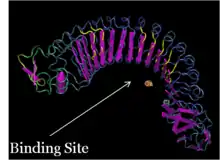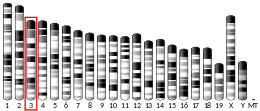| LRRC40 | |||||||||||||||||||||||||||||||||||||||||||||||||||
|---|---|---|---|---|---|---|---|---|---|---|---|---|---|---|---|---|---|---|---|---|---|---|---|---|---|---|---|---|---|---|---|---|---|---|---|---|---|---|---|---|---|---|---|---|---|---|---|---|---|---|---|
| Identifiers | |||||||||||||||||||||||||||||||||||||||||||||||||||
| Aliases | LRRC40, dJ677H15.1, leucine rich repeat containing 40 | ||||||||||||||||||||||||||||||||||||||||||||||||||
| External IDs | MGI: 1914394 HomoloGene: 9825 GeneCards: LRRC40 | ||||||||||||||||||||||||||||||||||||||||||||||||||
| |||||||||||||||||||||||||||||||||||||||||||||||||||
| |||||||||||||||||||||||||||||||||||||||||||||||||||
| |||||||||||||||||||||||||||||||||||||||||||||||||||
| |||||||||||||||||||||||||||||||||||||||||||||||||||
| Wikidata | |||||||||||||||||||||||||||||||||||||||||||||||||||
| |||||||||||||||||||||||||||||||||||||||||||||||||||
Leucine rich repeat containing 40 (LRRC40) is a protein that in humans is encoded by the LRRC40 gene.[5]
Species distribution
LRRC40 is conserved throughout all of its orthologs. The entire protein is highly conserved in mammals, while conservation is high within the leucine rich repeats in the rest of the orthologs.[6] Orthologs were found all the way back to the scarlet sea anemone and homologs were found in bacteria and Archaea using BLAST.[7] The following table gives information on the homologs of LRRC40.
| Genus species | Organism common name | Divergence from humans (MYA) [8] | NCBI mRNA accession | Sequence similarity [7] | Protein length | Common gene name |
|---|---|---|---|---|---|---|
| Homo sapiens[9] | Humans | -- | NM_017768 | 100% | 602 | LRRC40 |
| Pan troglodytes[10] | Common chimp | 6.4 | XM_513483 | 99% | 602 | Hypothetical protein |
| Pongo abelii [11] | Orangutan | 15.8 | NM_001131180 | 99% | 602 | LRRC40 |
| Macaca fascicularis [12] | Long-tailed macaque | 30.2 | AB179219 | 99% | 602 | Full LRRC40 |
| Callithrix jacchus [13] | Common marmoset | 43.9 | XM_002750952.1 | 99% | 602 | Predicted: LRRC40 |
| Sus scrofa [14] | Wild boar | 92.5 | XM_003127928 | 96% | 602 | Predicted: LRRC40 like protein |
| Mus musculus [15] | Mouse | 94.1 | NM_024194 | 92% | 602 | LRRC40 |
| Monodelphis domestica [16] | Opossum | 160.2 | XM_001379417 | 86% | 598 | Hypothetical protein |
| Gallus gallus [17] | Chicken | 274.8 | NM_001031295 | 85% | 603 | LRRC40 |
| Taeniopygia guttata [18] | Zebra finch | 274.8 | XM_002188367 | 85% | 605 | Predicted: LRRC40 |
| Xenopus (Silurana) tropicalis [19] | Western clawed frog | 389.7 | NM_001011310 | 80% | 605 | LRRC40 |
| Danio rerio [20] | Zebrafish | 444.3 | NM_199862 | 83% | 601 | LRRC40 |
| Salmo salar [21] | Salmon | 444.3 | BT043621 | 82% | 600 | LRRC40 |
| Nematostella vectensis [22] | Scarlet sea anemone | 830.3 | XM_001640230 | 66% | 602 | Predicted protein |
| Culex quinquefasciatus [23] | Southern house mosquito | 838.3 | XM_001842697.1 | 58% | 612 | LRRC40 |
Gene
LRRC40 is located on the negative DNA strand (see Sense (molecular biology)) of chromosome 1 from 70,611,483- 70,671,223.[24] The gene produces a 2958 base pair mRNA. There are 15 predicted exons in the human gene [9] with four other splice patterns predicted on GeneCards by the Alternative Splice Database.[25]
Gene neighborhood
LRRC40 is neighbored downstream by LRRC7 (70,225,888 - 70,587,570) on the positive DNA strand and upstream by SRSF11 (70,687,320-70,716,488) on the positive DNA strand.
Gene expression
LRRC40 is expressed between the 50th and 100th percentile in almost every tissue in the body.[26]
Protein
While the exact function of the LRRC40 protein is not yet understood, it is believed to participate in protein-protein interactions because it is a member of the leucine rich repeat family of proteins which are known to participate in protein-protein interactions.[27]
Properties
LRRC40 is a 602 amino acid protein with a molecular weight of 68.254 kDa and an isoelectric point of 6.04.[28] LRRC40 is expected to localize to the nucleus[29] and has no transmembrane domains to anchor it to the nuclear membrane. LRRC40 has many predicted phosphorylation sites. Of the 19 predicted phosphoserine sites, only two are conserved within the orthologs.[30] These two sites are S38 and S391.
Protein structure
The secondary structure of the protein has a pattern within the leucine repeat regions. Each leucine repeat has a β-sheet and α-helix. The image to the right shows the particular horseshoe-like structure of a protein with many leucine rich repeats. Depending on the area where the LRRs are located, other proteins can bind within the curve of the horseshoe or attach to the outside of the protein.

Protein interactions
According to Genecards, LRRC40 has 756 possible protein interactions.[25] These interactions are based on results in the Molecular Interaction database which provided two possible protein interactions. The two proteins are described in the table below.
| Abbreviation | Protein name | NCBI protein accession | Cellular location | Function |
|---|---|---|---|---|
| CDC5L | Cell division cycle 5-like protein | NP_001244 | nucleus | transcription regulation and mRNA processing [32] |
| SNW1 | Ski-interacting protein | NP_036377.1 | nucleus | mRNA processing [33] |
References
- 1 2 3 GRCh38: Ensembl release 89: ENSG00000066557 - Ensembl, May 2017
- 1 2 3 GRCm38: Ensembl release 89: ENSMUSG00000063052 - Ensembl, May 2017
- ↑ "Human PubMed Reference:". National Center for Biotechnology Information, U.S. National Library of Medicine.
- ↑ "Mouse PubMed Reference:". National Center for Biotechnology Information, U.S. National Library of Medicine.
- ↑ "Entrez Gene: leucine rich repeat containing 40".
- ↑ Chenna R, Sugawara H, Koike T, Lopez R, Gibson TJ, Higgins DG, Thompson JD (July 2003). "Multiple sequence alignment with the Clustal series of programs". Nucleic Acids Res. 31 (13): 3497–500. doi:10.1093/nar/gkg500. PMC 168907. PMID 12824352.
- 1 2 "NCBI BLAST".
- ↑ "Time Tree".
- 1 2 "NCBI Nucleotide: NM_017768.4". 24 June 2018.
- ↑ "NCBI Nucleotide: XP_513483". 20 March 2018.
- ↑ "NCBI Nucleotide: NM_001131180". 19 February 2022.
- ↑ "NCBI Nucleotide: AB179219". 6 October 2006.
- ↑ "NCBI Nucleotide: XM_002750952.1". 18 May 2010.
- ↑ "NCBI Nucleotide: XM_003127928". 13 May 2017.
- ↑ "NCBI Nucleotide: NM_024194". 13 August 2022.
- ↑ "NCBI Nucleotide: XM_001379417". 27 April 2016.
- ↑ "NCBI Nucleotide: NM_001031295". 9 March 2022.
- ↑ "NCBI Nucleotide: XM_002188367". 12 February 2013.
- ↑ "NCBI Nucleotide: NM_001011310". 19 June 2021.
- ↑ "NCBI Nucleotide: NM_199862". 20 November 2021.
- ↑ "NCBI Nucleotide: BT043621". 24 November 2009.
- ↑ "NCBI Nucleotide: XM_001640230". 31 January 2009.
- ↑ "NCBI Nucleotide: XM_001842697.1". December 2009.
- ↑ "NCBI Gene: 55631".
- 1 2 "GeneCards: LRRC40".
- 1 2 "GEO Profiles: LRRC40 GDS596".
- ↑ Kobe B, Kajava AV (December 2001). "The leucine-rich repeat as a protein recognition motif". Curr. Opin. Struct. Biol. 11 (6): 725–32. doi:10.1016/S0959-440X(01)00266-4. PMID 11751054.
- ↑ "ExPASy: Compute PI/Mw". Archived from the original on 2003-07-23.
- ↑ "PSORTII: Protein Localization Tool".
- ↑ "NetPhos 2.0 Server: Phosphorylation Prediction".
- ↑ "NCBI MMDB: Inla S192n G194S".
- ↑ "MINT: CDC5L". Archived from the original on 2013-02-18.
- ↑ "MINT: SNW1". Archived from the original on 2013-02-18.



